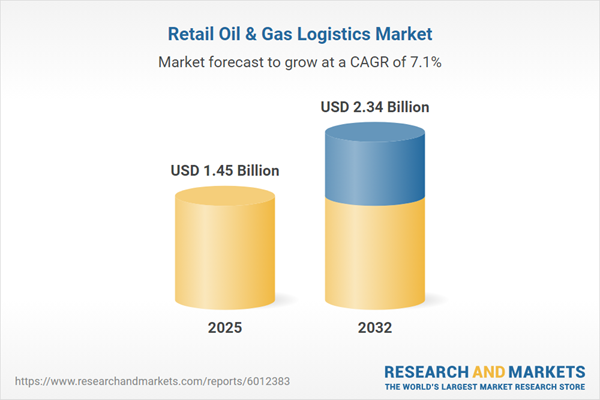Speak directly to the analyst to clarify any post sales queries you may have.
Senior leaders in the retail oil and gas logistics market are navigating unprecedented transformation. Evolving global regulations, sustainability demands, and digital technologies require organizations to rethink operating models and sharpen compliance, resilience, and agility across their value chains.
Market Snapshot: Retail Oil and Gas Logistics Market Growth & Dynamics
The retail oil and gas logistics market is experiencing steady expansion as operators restructure supply chains and adapt to regulatory shifts. Growing competition is accelerating the adoption of analytics, automation, and digital solutions, enabling smarter decisions and efficiency gains. Senior executives are focusing on collaboration with suppliers, as well as investments in decarbonization to address shifting investor priorities. Together, these strategies are pushing the industry toward greater flexibility, supporting ongoing transformation and helping companies remain adaptive in a complex and changing environment.
Scope & Segmentation of the Retail Oil & Gas Logistics Market
This report provides executive analysis and scenario-based insights across core segments of the retail oil and gas logistics value chain. Granular segmentation supports operational benchmarking, competitive positioning, and informed investment decisions spanning technologies, regions, and partnership models.
- Transportation Modes: Marine, pipeline, rail, and road logistics are assessed to highlight contributions to reliable bulk movement and infrastructure stability under varying market dynamics.
- Service Types: Bulk distribution, direct delivery, and storage formats such as pressurized, refrigerated, above-ground, and underground methods are compared for responsiveness to shifting demand and compliance requirements.
- Fuel Types: Analysis of gaseous fuels (CNG, LPG, butane, propane) and liquid fuels (diesel, gasoline, kerosene) illustrates operational best practices in safety and regulatory conformity.
- Logistics Provider Types: In-house, third-party (3PL), and fourth-party (4PL) provider models are examined to align technology adoption and outsourcing with evolving supply challenges.
- Infrastructure Types: Collection terminals, distribution hubs, and specialized storage are reviewed to guide investments supporting high-volume, regulated product movement in modern networks.
- Regional Coverage: Americas, Europe, Middle East, Africa, and Asia-Pacific are covered, supporting tailored strategies based on local regulations, infrastructure, and operational environments.
- Company Analysis: Sector leaders—China Petroleum & Chemical Corporation, PetroChina, Indian Oil, Exxon Mobil, Shell, BP, Chevron, TotalEnergies, Marathon Petroleum, and Valero Energy—are profiled to enable benchmarking of operational and innovation performance.
Key Takeaways for Senior Decision-Makers
- Integrating digital analytics and predictive maintenance sharpens risk identification and enhances decision-making across logistics operations.
- Upgrading storage and terminals helps support compliance initiatives while enabling emission reduction as standards become more rigorous.
- Strengthening supplier collaboration and flexible procurement improves adaptability, reducing exposure to unpredictable disruptions.
- Investing in sustainable facilities and alternative fuel adoption positions organizations to meet stakeholder and regulatory expectations.
- Engaging experienced logistics partners broadens operational reach, especially in regions with varying geographic or network complexities.
- Deploying region-specific compliance frameworks allows tailored operating models, enhancing both regulatory alignment and commercial performance.
2025 United States Tariff Impact
Recent tariffs in the United States have increased costs for imported pipeline infrastructure and specialized equipment in the retail oil and gas logistics sector. To address these challenges, companies are shifting toward domestic sourcing, adapting supplier contracts, refining maintenance schedules, and prioritizing local manufacturing investments. These strategies help manage higher costs and secure supply continuity in response to changing trade policy.
Methodology & Data Sources
This report draws on industry interviews with senior executives, direct insights from logistics managers, and analysis of regulatory documents and market datasets. Findings are expert-validated to ensure actionable relevance for senior leadership.
Why This Report Matters
- Provides decision-makers with practical benchmarks and frameworks for navigating digital transformation, modernization, and compliance across the retail oil and gas logistics market.
- Enables leadership to implement strategies that optimize logistics resilience, advance sustainability, and strengthen regulatory adherence within competitive and evolving global settings.
Conclusion
Senior executives gain a clear roadmap for adapting to ongoing changes in retail oil and gas logistics. This report supports strategic vision and resilience as market dynamics and sustainability priorities continue to evolve.
Additional Product Information:
- Purchase of this report includes 1 year online access with quarterly updates.
- This report can be updated on request. Please contact our Customer Experience team using the Ask a Question widget on our website.
Table of Contents
3. Executive Summary
4. Market Overview
7. Cumulative Impact of Artificial Intelligence 2025
Companies Mentioned
The companies profiled in this Retail Oil & Gas Logistics market report include:- China Petroleum & Chemical Corporation
- PetroChina Company Limited
- Indian Oil Corporation Limited
- Exxon Mobil Corporation
- Shell PLC
- BP p.l.c.
- Chevron Corporation
- TotalEnergies SE
- Marathon Petroleum Corporation
- Valero Energy Corporation
Table Information
| Report Attribute | Details |
|---|---|
| No. of Pages | 190 |
| Published | November 2025 |
| Forecast Period | 2025 - 2032 |
| Estimated Market Value ( USD | $ 1.45 Billion |
| Forecasted Market Value ( USD | $ 2.34 Billion |
| Compound Annual Growth Rate | 7.0% |
| Regions Covered | Global |
| No. of Companies Mentioned | 11 |









